When Nikki Chamberlain’s plans were disrupted by the pandemic, she didn’t sit around stewing in frustration or embracing a sense of helplessness, but instead climbed onto a Suzuki Savage motorcycle to peel off on a sojourn into the soul of a wounded nation.
This two-wheel pilgrimage brought her from one coast to another: It would include Chamberlain rolling up to the sinister, cartoonish colors of the Clown Motel in Nevada’s desert; and spending time with the eerie story-swappers living in a trailer park outside Area 51; and leaning against the worn wood rails of Butch Cassidy’s cabin in Cody, Wyoming; and revving past flat seas of sunflowers while steering for “The Yellow Brick Road” in southern Kansas. Her navigation even led her to cross paths with “skunk-ape hunters,” who search for Bigfoot’s swamp-dwelling cousin in the Florida Everglades. Before it was over, she drove along the flaming scarlet and apricot leaves that were exploding across New England in the fall.
Then, Chamberlain arrived in Washington D.C. during one of its most politically fraught and frightening moments in a generation.
Throughout her journey, the New Zealand native attracted a growing online community to her constant sense of adventure. She was known on Instagram as the Kiwicruisette. Chamberlain coupled her ride-along in real-time with Youtube videos that she was producing. They introduced the thousands following her to everything from giant “Mormon Crickets” along America’s loneliest highway, to the treacherously tight but stunning turns of Shell Canyon, Wyoming.
When the winter snows approached, Chamberlain finally returned to California, opting to make her home in South Lake Tahoe. She’s been working as a popular brewery hostess there ever since.
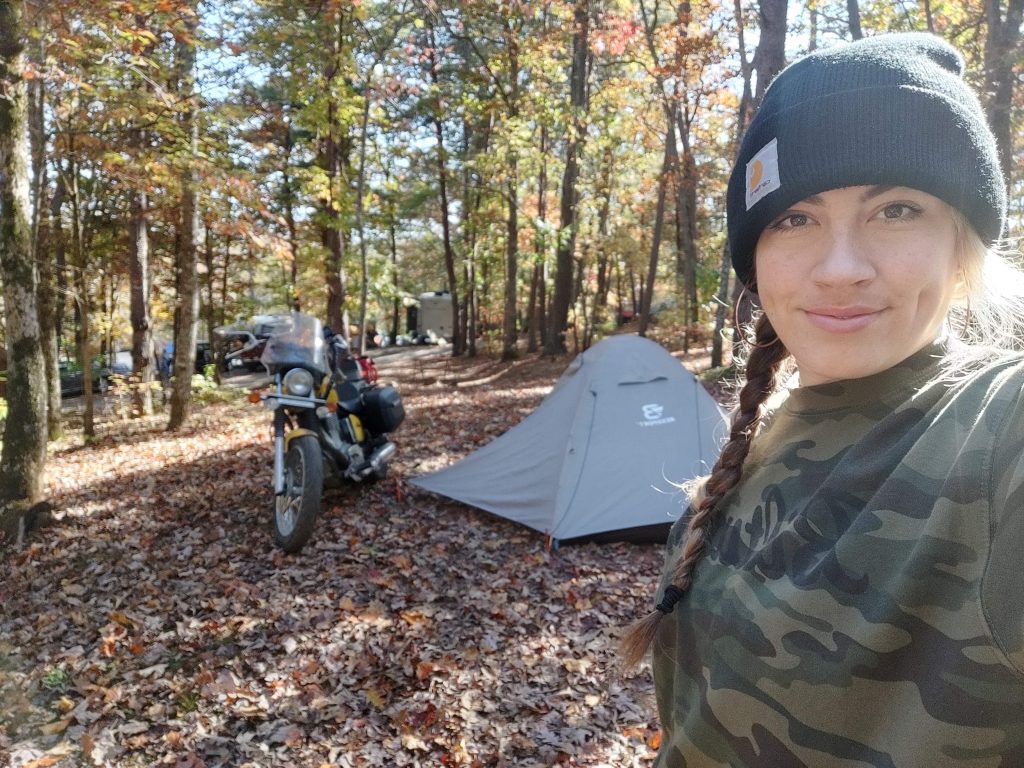
A few months ago, on October 17, Chamberlain was away from home when the motorcycle that bridged her to so many strangers around the country was stolen from her quiet, wooded neighborhood off Tahoe Boulevard. The snowmobile of a nearby resident met the same fate.
Chamberlain had an awareness that vehicle thefts are spiking all across California, but there was an element of the motorcycle caper she was struggling with: A GPS tracking device was fixed to the Suzuki. Chamberlain could see exactly where the missing bike was in rural El Dorado County. Specifically, it was off Highway 193 near the hill-hamlet of Georgetown. Trying to alert authorities, Chamberlain says she was given the pinball treatment between the law enforcement agency whose jurisdiction the motorcycle was stolen from, the department whose jurisdiction it ended up in, and the state officers who could have theoretical jurisdiction between the two. At one point, Chamberlain was even advised of a fourth law enforcement agency that might have a role to play.
In the end, no one wearing a badge went to recover the bike that Chamberlain had so much sentimental attachment to, despite every agency she reached out to knowing the GPS coordinates for it.
But that doesn’t mean that a peace officer did not inadvertently tip-off the thieve, or thieves, to the game of responsibility-dodge-ball that was happening. Chamberlain would ultimately confirm that someone did contact those in possession of the motorcycle in some fashion, at which point she didn’t get it back, but the tracking device was immediately deactivated.
Chamberlain says getting information about exactly how that happened was also like pulling teeth.
Now, the immigrant who peered through so many prisms of American idealism has some questions about the future of ‘California Dreamin’, particularly when it comes to rampant property crime and the basic conundrum of how much officials may actually be resigned to it.
It was only last week that she felt any hope for resolution. Chamberlain’s tracking software gave her a new ping on the bike through a different method and she was quickly connected with a sheriff’s deputy who took a genuine interest in her case.
But, despite that deputy’s better efforts, the motorcycle remains unrecovered.
Chamberlain wonders whether things would have been different if law enforcement had acted more decisively back in October. She also wonders if this is just the way things are now in the Golden State.
“I think the real message here, which I think other people will take away from this, is, ‘Is this something that we can come to expect?’” Chamberlain notes. “Is this representative of a bigger experience now? Is this a normal thing?”
‘Savage journey’
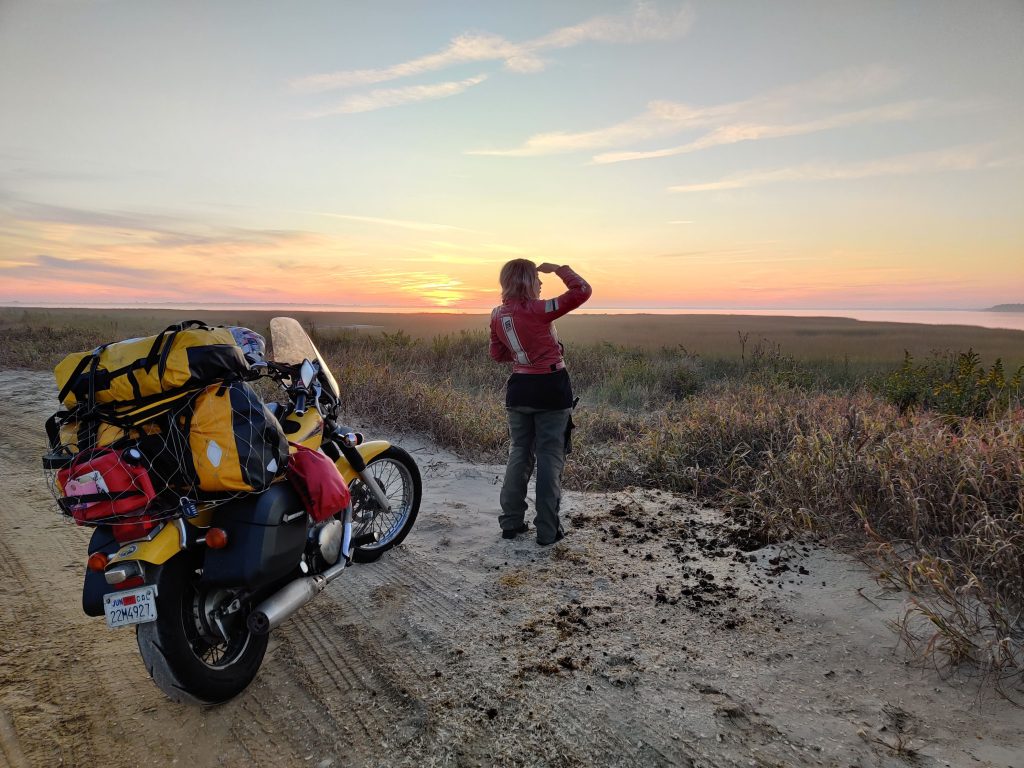
In the spring of 1971, the Chicano writer Oscar Zeta Acosta and trickster journalist Hunter S. Thompson went on a screeching trek through the tumbleweeds in search of something elusive: Given that the sixties’ optimism had just ended with the Manson Family’s gore-spattered scenes in LA – and the Rollings Stones’ bloody, murder-stricken concert at Altamont – the writers were asking everyone they met about the state of the American Dream. Though not directly inspired by the resulting book, “Fear and Loathing in Las Vegas,” Chamberlain was interested in a similar spiritual interrogation on the road after the pandemic threw her life in limbo.
The New Zealander had been living and working in San Francisco for two years before COVID crossed the shores. The resulting upheaval caused her to lose a high-paying job, which eventually led to losing her house north of the city’s panhandle. Wanting to parse the chaos and figure out where to set roots next, Chamberlain began contemplating an ambitious solo trip. She decided to pack a cook stove, a tent and some food onto the single-cylinder motorcycle that she typically used for commuting around San Francisco – and just tear out of the bay for the open highway.
Her plan was to hammer-down tent stakes each night in the national forest system, allowing her to soak in nature’s ever-changing beauty across The Lower 48. She let people know she was giving herself half-a-year to conquer the land.
“I think I was certainly running away,” she reflects. “I had felt a sense of shame because when I landed this really impressive job at a Big Tech company, I thought, ‘Oh my gosh, I’ve finally made it.’ That became a part of my identity. So, when I lost that, I guess I really wanted to prove something. By publicly declaring to everyone that I was leaving on this motorcycle and not coming back for six months, I was sort of holding myself accountable for this really big thing that I hoped would replace my sense of value. So, yeah, I was running away from the loss, but I was also trying to gain something new, which I felt could help me have some sense of achievement.”
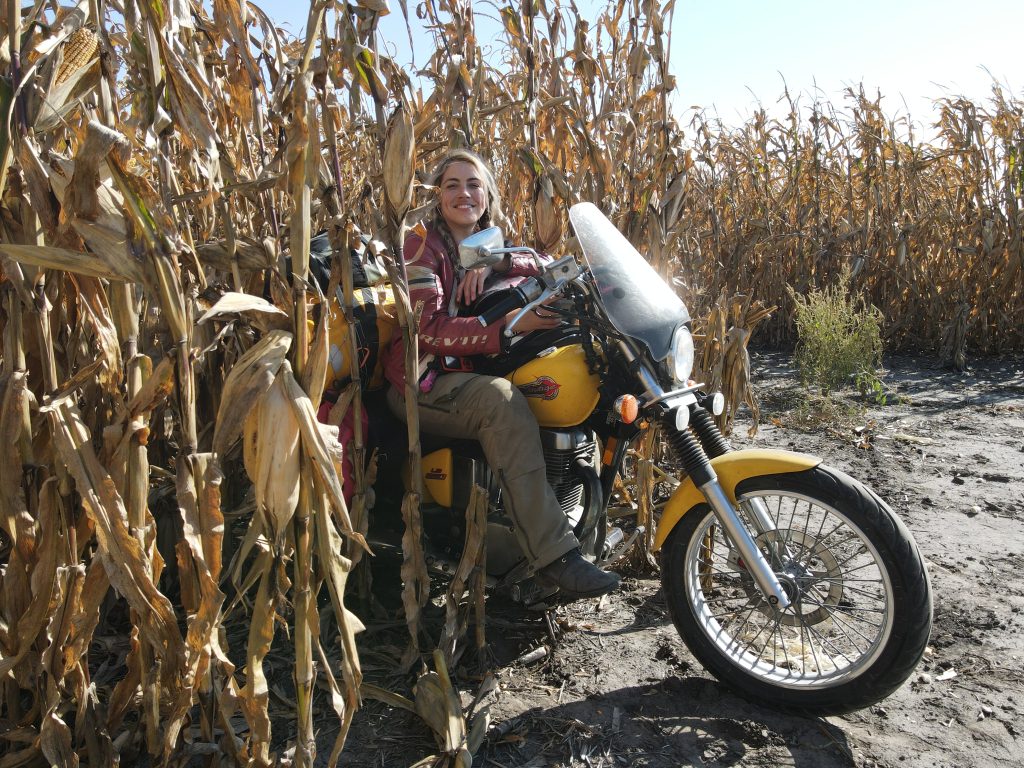
Chamberlain also set her sights on engaging the people she met throughout the trip about their visions of the American Dream. In 1971, Hunter Thompson sub-titled his treatise on the subject, “A savage journey to the heart of the American Dream.” Chamberlain was leaving for her own odyssey on a black and yellow Suzuki Savage.
It wasn’t long before the Kiwicruisette’s Instagram was sharing pics of her exploring hot springs along forested rivers in Idaho, or her meeting a traditional Amish family in Wisconsin with a hand-written sign for their makeshift bakery. By June, Chamberlain had released her first Youtube video in the style of a travel docu-series.
“I think the American Dream is to do better than your parents,” an older man mutters in a Nevada diner, bearing a kind of sunburned solitude over his giant Pepsi cup. “So, is the American Dream dead? No. But it’s much harder to obtain.”
Later, a gun-toting biker in the middle of the desert shared his own thoughts.
“For me, the American Dream now is for my kids and my grandkids,” he says. “I want them to have the same opportunities I had, even though I blew most of em.”
Chamberlain also started making videos about what she was learning as a solo traveler. People from around the country were interacting with her on Instagram, some even offering her houses or cabins to stay in when the weather got tough. Throughout it all, Chamberlain kept stopping at gas stations to talk to strangers about the American Dream. By then, the 2020 Presidential campaign was beginning to reach a boiling point. The tension found its way into many of the exchanges Chamberlain had across the rural openness.
Generally, people weren’t on guard around her. Anyone who heard Chamberlain speak for even a few seconds knew she wasn’t originally from the U.S. While the New Zealand accent can be hard for some Americans to peg, Chamberlain doesn’t sound like a woman hailing from Los Angeles or Brooklyn – or anywhere in between. She says this seemed to relax many of the random Americans she met about sharing their passionate political views.
“It was super curious to me, and I felt like I could approach the topic from a place of truly just wanting to look in with a magnifying glass because I didn’t have any skin in the game,” Chamberlain observes. “I can’t vote, so people felt like there was nothing to be gained by trying to influence me with their decision. I just found it interesting how willing everyone was to talk.”
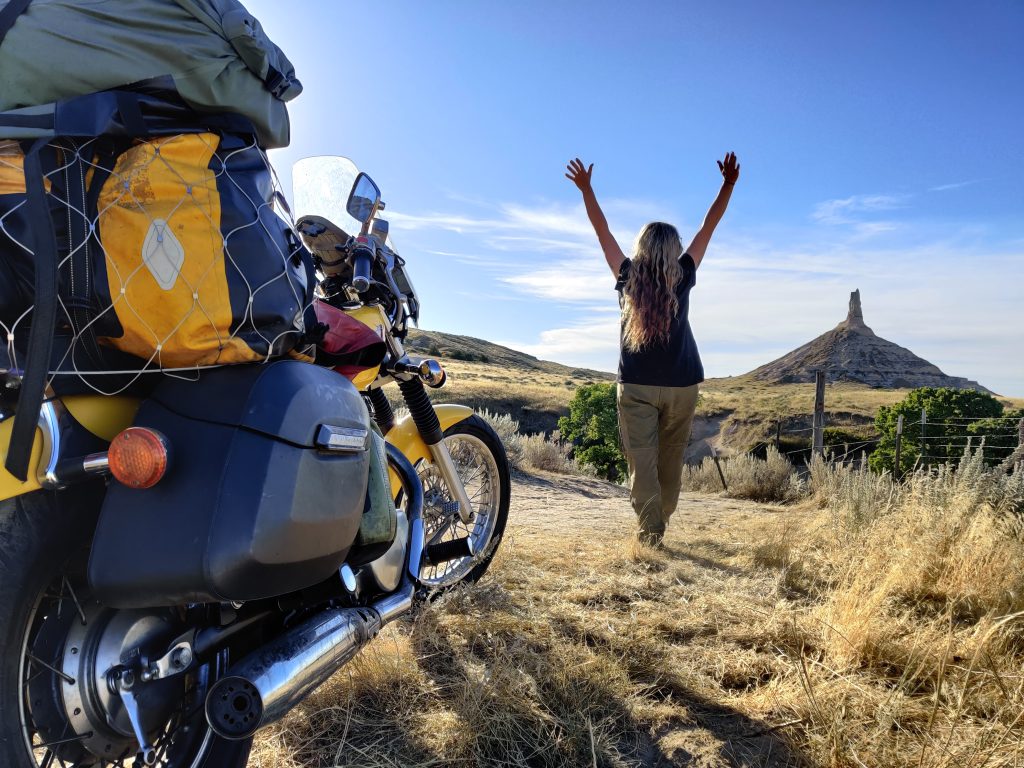
As much as these interactions fascinated the Kiwicruisette, as November of 2020 approached – like almost everyone – she could feel America’s check-engine light flashing hot, dangerous red. Chamberlain pulled into Washington D.C. on her Suzuki Savage around Election Day. What would follow was wandering through the nation’s capital over a tense 72 hour period as everyone waited for something like indisputable results.
Then, the country’s night-tossed fever suddenly broke.
“I was waiting and waiting, and finally some guy just came barreling out of his house, just screaming at top of his lungs ‘Joe!’” Chamberlain remembers. “And it felt like, out of nowhere, people just pulled out these flags, and then got in their cars – and we all just headed Downtown.”
With a chuckle, she adds, “And I thought, ‘Have you guys all just been waiting inside with your flags this whole time?’ It was a real party atmosphere – and bizarre, to say the least.”
In “Fear and Loathing in Las Vegas,” Thompson described the late 1960s in San Francisco as a moment when the American Dream was almost in view – almost fully glimpsed by a generation that was “riding the crest of a high and beautiful wave,” until the point when that wave “finally broke and rolled back,” leaving only “a high watermark” on the dry desert mountains as a reminder that it was once real enough to squint towards.
During her own cultural surf-riding, Chamberlain hadn’t seen that dream in full-view either. She had learned, though, that most people still want to believe in it, even when quietly admitting that its size and shine was diminishing fast in their consciousness.
Thieves in the night
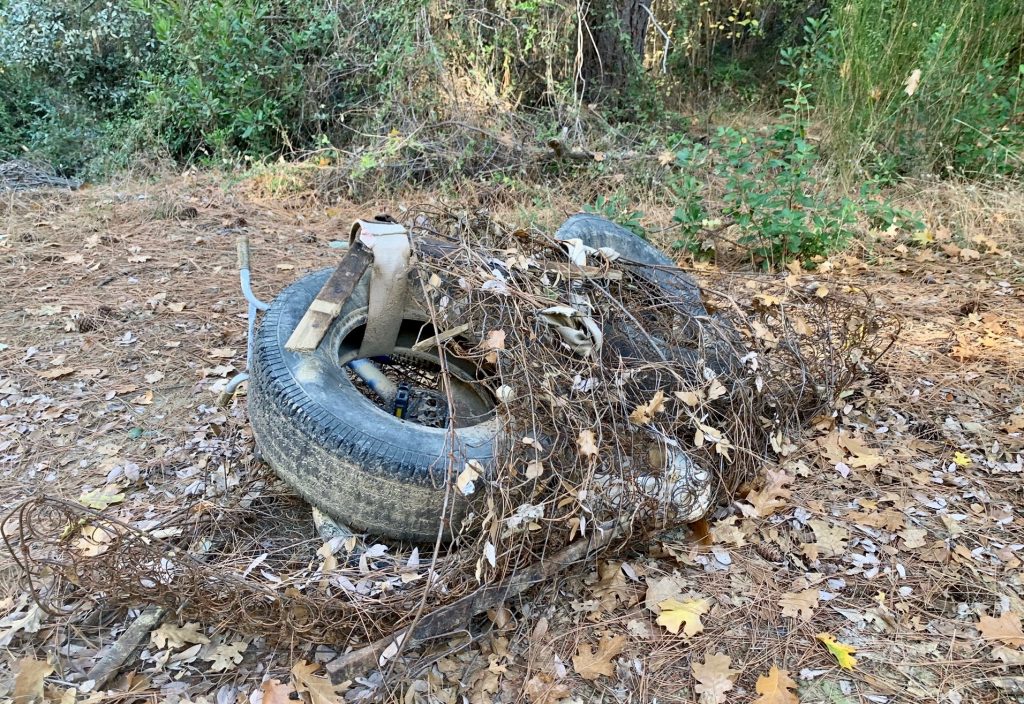
Throughout Chamberlain’s months on the road, one question that sometimes came up from friends and family involved whether she was scared of be traveling by herself.
“You know, all these headlines that we read,” she points out. “The truth is your average American is one of the most-kindest and fascinating – and fascinated – type of people you’ll ever meet. And that’s even true knowing that every kind of stereotype is also out there in the wild, which can also be hilarious if you’re checking off your bingo card.”
So, Chamberlain isn’t someone who obsesses over crime. However, in October of this year, she had a reason to contemplate the ballooning vehicle thefts and car burglaries hitting the state after her cherished motorcycle was snatched.
Chamberlain lives in a picturesque cabin under Tahoe’s pines with neighbors to both sides of her. She was away when the incident happened. Returning, her first instinct was the obvious one – call the South Lake Tahoe Police Department. After all, that was whose jurisdiction the crime was committed in. Tahoe officers met her and took a report. At some point after they left, Chamberlain suddenly remembered there was a Tile tracking device on her Suzuki. She opened her app to see the tracker pinging about six miles down Sliger Mine Road off Highway 193. The area is part of a remote ranching enclave called Greenfield, which is west of Georgetown. Sliger Mine Road itself peels off the highway just across from an isolated, time-worn mountain bar called Lance’s Place. Then the road goes winding up into the hills past dotting horse corrals, cattle yards and sheep pens. SN&R later confirmed that the first location where the missing motorcycle pinged is an isolated back corner of the road past its pavement giving way to a broken dirt corridor under the oaks. It is a part of Sliger Mine where houses are increasingly scarce.
“I could not only see the road, but I could see the exact location on the property where it was,” says Chamberlain. “It was inside four walls at the back of the residence. So, my guess would be a shed. Using Google maps, I could find out the exact number on the property.”
Chamberlain shared this revelation with the South Lake Tahoe Police. Though it’s not unheard of for California peace officers to cross into neighboring jurisdictions for investigative work tied to their patrol areas, Chamberlain says that South Lake Tahoe police dispatch insisted that the case now belonged to the El Dorado County Sheriff’s Office. That’s because the bike was pinging in Greenfield. A Tahoe dispatcher forwarded the information to the El Dorado sheriffs, telling Chamberlain to follow up with them.
Chamberlain’s house is within El Dorado County borders, so she had no reason to think the case would instantly go cold.
But it did.
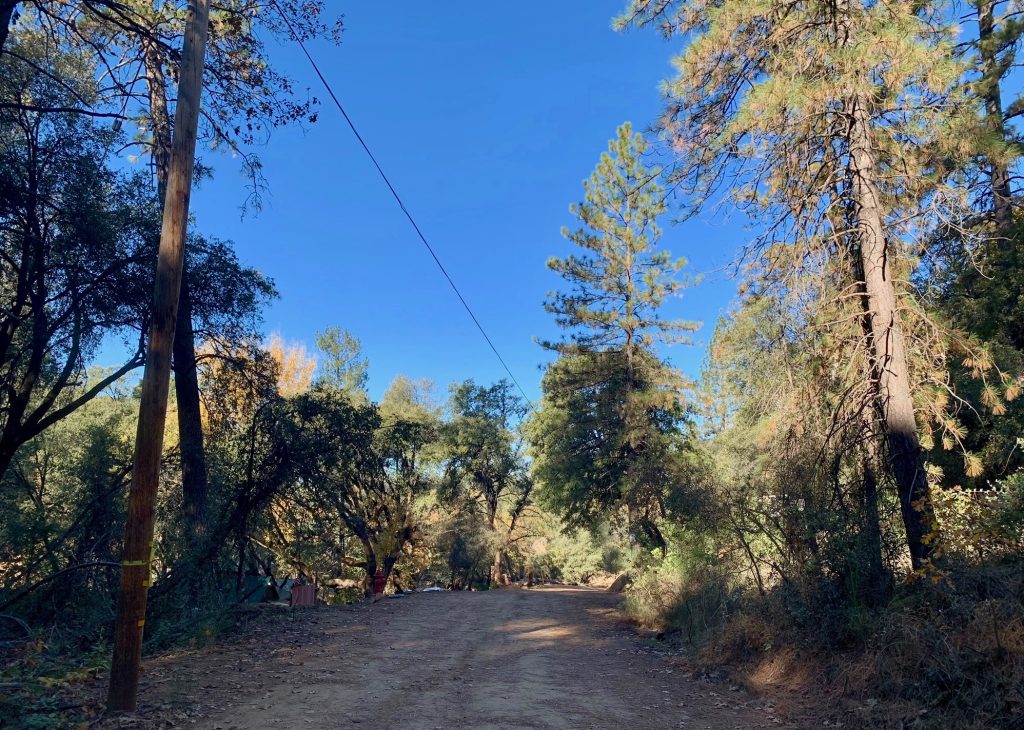
Eventually, Chamberlain received an email from Tahoe police confirming that El Dorado County deputies had gone down Sliger Mine Road and approached the property, but were unable to locate the motorcycle. At nearly the exact same time, on Oct. 19, the tracker on her motorcycle abruptly turned off. Chamberlain called the sheriff’s dispatch, a member of which, she says, revealed there was no record of her case at all.
The Kiwicruisette was perplexed.
“They don’t seem to have a record of actually going out, but they’ve told the South Lake Tahoe Police they have,” she recalls.
Chamberlain kept trying to clarify things with El Dorado’s dispatch, who then reportedly told her that either she was confused, or South Lake Tahoe Police were confused, or that possibly it was the California Highway Patrol that had gone out to the property since this was a case of a stolen vehicle.
Chamberlain was transferred to CHP. She explained the circumstances and gave a description of her motorcycle. After running a check, CHP confirmed there was no record of its own officers visiting Sliger Mine Road. Before Chamberlain got off the line, CHP mentioned that a fourth law enforcement agency who might need to be involved – the state park rangers.
“They told me that, in fact, the area that the bike was pinging from is in the California Parks and Recs jurisdiction,” Chamberlain recites with a sign. “It felt like a hot potato.”
Having now been advised about four different law enforcement agencies whose theoretical job it might be to recover her stolen property, Chamberlain decided to go down to the South Lake Tahoe Police Department in-person, since they took the initial report. Explaining her bewilderment, Tahoe police ran another systems-check and determined, Chamberlain says, that it was indeed El Dorado Sheriff deputies who’d gone to the property after all. Armed with that information, Chamberlain tried calling the Sheriff’s Office again. In her recollection, the person she spoke to his time wasn’t just unhelpful or out-of-the-loop, he was downright dismissive.
“That’s when I got this grumpy guy who was like, ‘Sorry? Who are you?’” she remembers. “He told me in no uncertain terms that he couldn’t give me any more information about what ‘checking it out’ meant. Because I really wanted to know if they had searched inside the property, if they’d tried to get a warrant, or if they had just drove by or knocked on the door.”
Chamberlain was then instructed that, as a victim, her only way to get more information would involve filling out paperwork that would take at least ten days to process.
“At that point, I got the strong impression that no one cared,” she acknowledged. “Plus, the one lead we had was actively ruined. So, I kind of gave up.”
Reached by phone this week, South Lake Tahoe Police Chief David Stevenson told SN&R that he regrets how his department handled Chamberlain’s case. Stevenson acknowledged that after the GPS ping came in, his dispatchers should have put Chamberlain directly in touch with an actual police officer. Then, Stevenson went on, that officer should have called the El Dorado County Sheriff’s Office to directly coordinate with whichever deputy was going out to check the property. He says this would have allowed the departments to have better communication and ultimately give Chamberlain more answers about what was happening.
“Looks like we dropped the ball on her,” the chief said. “We didn’t help her, or provide the right service. I’m still piecing together how it happened.”
According to the National Insurance Crime Bureau, California led the nation in 2021 with the highest number of vehicle thefts by volume. That number was up roughly 8% from the previous year, which itself was up from the year before. This trend in 2021 amounted to some 200,524 vehicles getting swiped in California, more than double that of Texas, which had the next highest spot on the list.
Ironically, in the same month that Chamberlain was going through this ordeal, El Dorado County’s top law enforcement official, District Attorney Vern Pierson, was decrying the way that property crime victims are treated during an interview with California Insider. In that exchange, the show’s host told Pierson that “some people are saying that theft is now legal in California,” to which the veteran prosecutor responded: “What we’ve done is that we’ve convinced a large number of people in the state that there is no consequence for their actions, and we have this increased lawlessness that comes from it. The view is, ‘I can take other peoples’ property because nothing will happen to me.’”
Pierson was specifically criticizing the voter-approved Prop. 47 that was passed eight years ago, which lowered property crime penalties in order to alleviate California’s prison-overcrowding. That measure was crafted in the wake of a federal ruling that overcrowding had led to dangerous and even deadly conditions in the states’ prisons, hence it violated inmates’ constitutional rights. The initial judgement was handed down in 2007 and later upheld by the U.S. Supreme Court in 2010. While cautioning that he’s no fan of mass incarceration during his California Insider appearance, Pierson argued that Prop. 47 was strategically flawed, resulting in culminating and cascading effects on criminally minded individuals.
“Theft’s not technically legal, but not enforced is the better way to put it – certainly if it’s less than $950,” Pierson went on. “With the passage of Prop. 47 … we looked at most property crimes that were being prosecuted at that time and said that many of them that were felonies are now misdemeanors, and many that were misdemeanors were essentially nothing, and there’s a lack of enforcement … There’s been a number of different studies that have been done that say we have the same people who are stealing over and over again, and when they’re caught, there’s no consequence … When you turn on the news, when you turn on Youtube, and see these smash-and-grabs taking place, or large-scale thefts, and then you have Walgreens, let’s say, closing their stores [in California], or more recently Starbucks saying, ‘We’re going to close stores in certain areas because we can’t deal with the crime that’s associated with it,’ I think it’s something that increases over time.”
Chamberlain’s motorcycle, according to J.D. Power Company, is worth between $720 and $1,450, depending on how a buyer views its condition. In other words, under Prop. 47’s $950 threshold for theft, the crime might be a felony, but it might not.
According to the California Attorney General’s Office, the overall property crime rate in California was up only 3% in 2021. For some, that’s not a huge increase. Criminal justice reform advocates have also stressed that the burglary rate itself in California fell by 5.3% in that same window. However, Pierson and other law enforcement officials have warned those stats are compromised because of how seldom commercial businesses are bothering to report the rampant theft they’re experiencing, given that the best they can hope for is something akin to a traffic citation for which the guilty parties are rarely held to answer, at least in larger cities. Vehicle theft and car burglaries, these officials argue, are the main theft categories to monitor because the Insurance Industry mandates that they be reported.
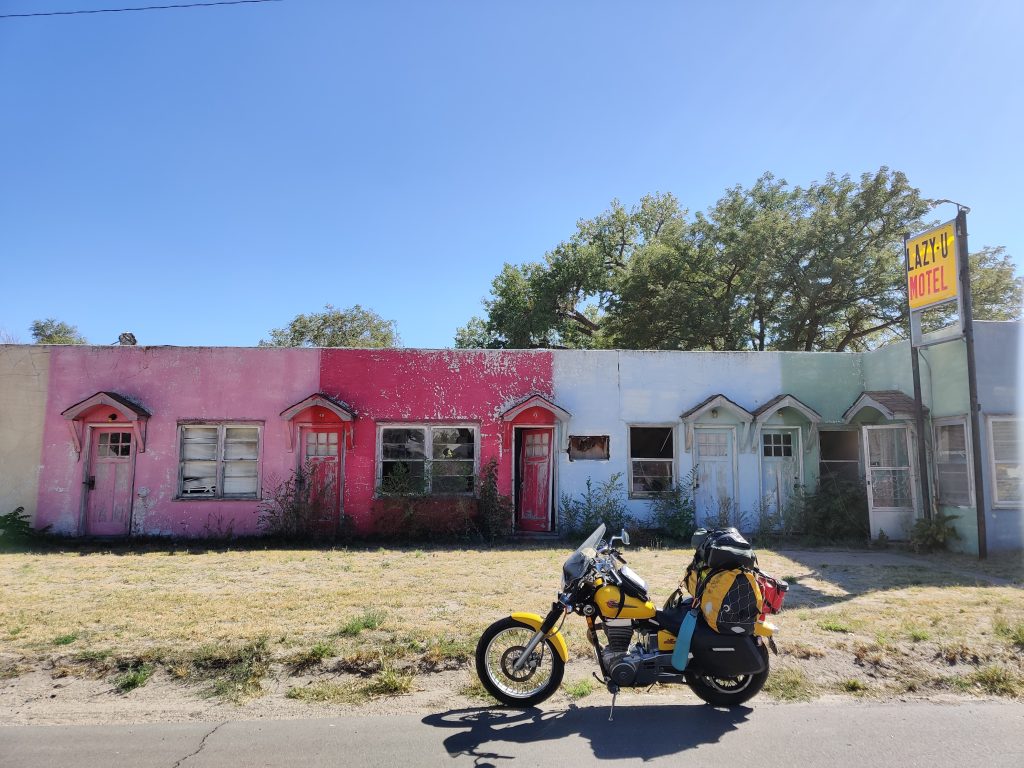
Chief Stevenson told SN&R, without having stats in front of him during his interview, he estimates property crime in South Lake Tahoe is slightly up, but not manifesting in the sudden spike that many California jurisdictions are seeing now.
“COVID changed everything, including the perceptions around how and why people are committing crimes,” Stevenson noted. “In our little bubble of El Dorado County, it’s almost stayed the same, I think. But it does seem like drug use has been up the last few years, and substance abuse disorders and property crimes do correlate sometimes – you just have people desperate to pay for their addiction.”
Similar to those store owners Pierson mentioned who are no longer reporting theft, Chamberlain had all but waved the white flag on her missing motorcycle when something unexpected happened last week: She’d previously reported her bike ‘stolen’ within her Tile app. The app suddenly notified her that someone else with a tile tracker had just come in close contact with her own missing tracker, resulting in a new ping off the other user’s phone. Chamberlain could see that the fresh alert was at a property just a short distance from the first property the motorcycle had pinged on. She called the El Dorado Sheriff’s Office and was soon speaking with a deputy named Ryan Huisman, who struck her as professional, proactive and concerned.
“It was a much better response this time around,” Chamberlain says. “Once I explained to him that it was coming from a new location and it was likely because someone had driven past with another Tile, [he] understood and he went out to the property that evening … He spent about an hour looking around and he kept in contact … His response was completely opposite to the first incident.”
Unfortunately, the motorcycle still was not found. Chamberlain doesn’t seem to be dwelling on that. Given that she’s still tied to San Francisco on social media, she knows that many, many people have had similar experiences the last few years. She’s seen the ugly images on her various apps and feeds. But in this era of crushing inflation, skyrocketing rents and an ever-widening wealth gap, increased property crime is just one more stressor that everyday people have to contend with to keep on keepin’ on in California.
Lately, those stressors are really adding up for residents from sea to shining sea. Chamberlain knows this from her journey she took on the motorcycle.
“Everyone pretty much believes the American Dream is essentially to be able to have a better life than your parents, and to have a piece of something that’s your own, along with this concept of freedom,” she remarks. “I think people still believe it’s a core tenent of what it means to live here; but what it seems like people are struggling with is how the access has changed and who gets to participate … There are still plenty of people who have an older way of looking at things, and to them, it’s still very real; but for me, having lived in a city here, and coming in as immigrant, I don’t believe that those people are truly being realistic about their children being able to have the same things they had.”

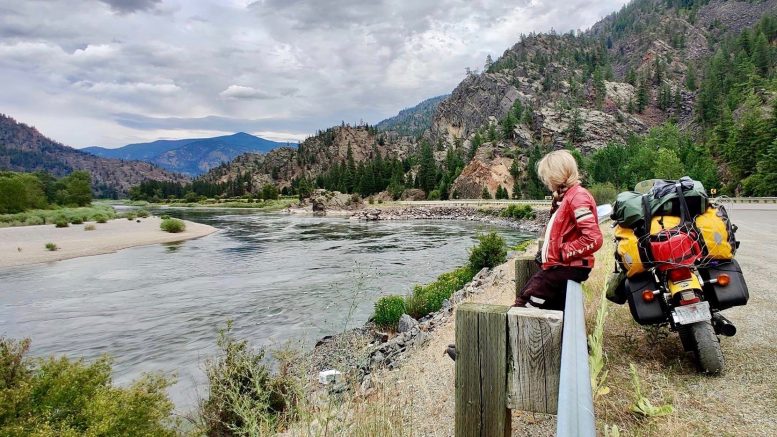

It seems we need to direct drug-using offenders to drug treatment facilities to reduce prison crowding. Jurisdiction issues in law enforcement or any other public service need a closer look. We need “seamless” services. How is that achieved? No answer here, just the question.